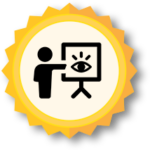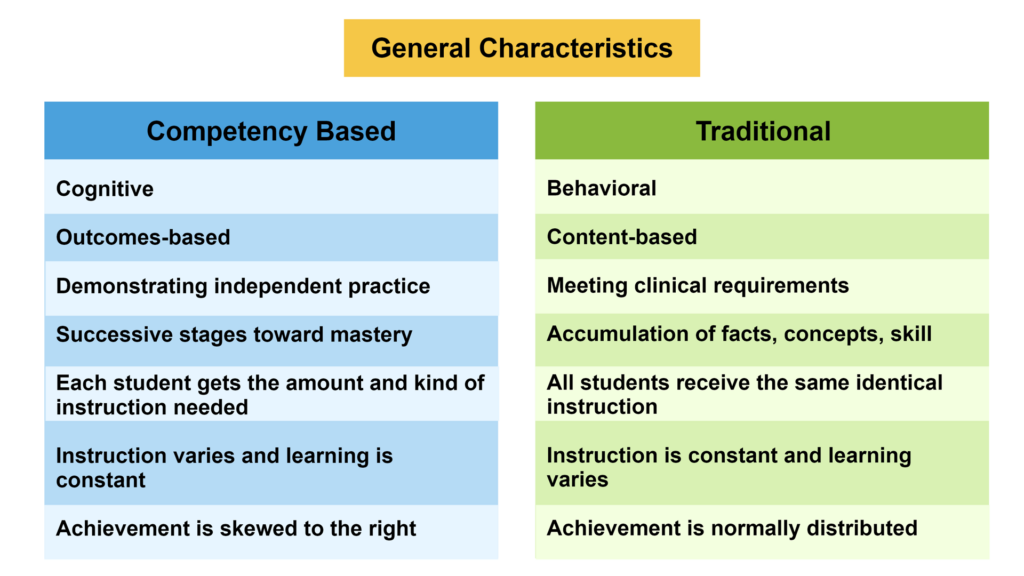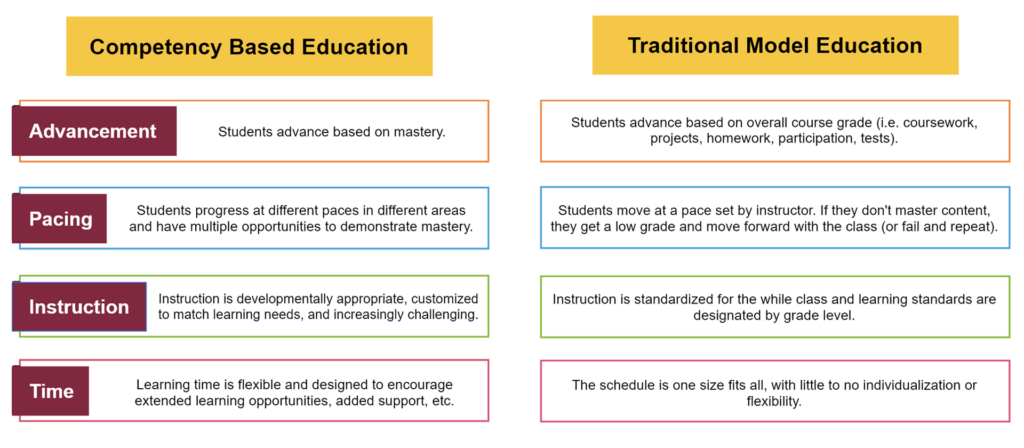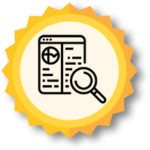Mastery or Competency Learning
 Overview and Introduction: The WHAT and WHO
Overview and Introduction: The WHAT and WHO
Mastery or Competency Learning focuses on students’ finishing or “mastering” a learning objective within each module, prior to moving on to the next learning module. This technique is in contrast to the “time-based” and/or “traditional” educational models of learning where students progress at the same rate regardless of if mastery is achieved. Common characteristics between Competency based learning and traditional learning are shown below in Table 1.

Table 1: Characteristics of Competency Based Learning Modules and Traditional Learning Modules. Adapted from: N. E Grunberg and E. S Barry, “Health and healthcare as Infinite Games,” Acta Scientific Medical Sciences, vol. 6, no. 3, pp. 110–116, 2022.
In an ideal course designed for mastery or competency learning, students achieve 100 percent on an objective prior to moving forward to a new topic. In practice, the goal is to give students as many possibilities to achieve a learning objective given the constraints of outside factors (e.g., time, policy). Students who achieve the learning objective may either go on to a new objective or can participate in “enrichment” activities that go deeper on a certain topic. The table below further delineates the characteristics of Competency Learning versus the traditional model of education Table 2.

Table 2: Components of Competency Based Learning Modules and Traditional Learning Modules. Adapted from: N. E Grunberg and E. S Barry, “Health and healthcare as Infinite Games,” Acta Scientific Medical Sciences, vol. 6, no. 3, pp. 110–116, 2022
Meta analyses, considered the most robust form of statistical analysis because results are included from many papers on a topic, indicate a medium-to-large effect size of mastery-based learning on student outcomes [1]. This effect size increases with topics that build on each other. For example, mathematical principles build on each other. A simple example: you can’t understand multiplication if you don’t understand addition. Thus, if the topic you are teaching requires students to build on a foundation of prior work, mastery learning approaches will benefit your students.
Studies show that mastery learning techniques increase grades, retention, student attitudes, and knowledge on assessments [3], [4], [5], [6] . Further, studies indicate that students also require fewer attempts as the course continues indicating that students also get better at learning [7].
This technique is particularly useful for student populations from diverse academic backgrounds such that they may have different levels of prior mastery [8]. In this way, mastery learning helps create a more equitable learning environment where all students can be successful.
No specific software or materials are needed, though mastery-based programs for upper division math and similar do exist online (e.g., Kahn Academy).
Depending on implementation strategy this can take very little additional time or a significant amount of faculty’s time. Strategies described below are labeled based on the amount of time required.
Any group will benefit from mastery learning; however, it is particularly important for
-
-
- topics that require strong foundations and build on prior content and
- student groups with diverse academic backgrounds.
-

 Implementation and Timing: The WHEN, WHERE, and HOW
Implementation and Timing: The WHEN, WHERE, and HOW
Mastery learning focuses on altering the assessment phase of learning to be more expansive and a larger part of the learning experience. During assessment, students are given multiple chances to demonstrate mastery. Students are given lots of opportunities to learn from mistakes. Quick and responsive feedback is required to use this technique well. However, one can create automated feedback based on most common issues for students to reduce faculty time and scale for large classrooms. Peer and near-peer feedback can also assist students. These scalable implementations are described below under the “how” section [9].
This is primarily implemented in the assessment phase of learning which can take place in the classroom or during homework assignments.
LOW effort example:
-
-
- Allow students to complete assignments multiple times.
- You may choose to do this just for homework assignments or for exams (or both). A good place to start is with homework or practice exams giving ample feedback to students so mastery is achieved prior to the exam.
- Feedback can be automated using online resources (canvas has this option).
- Depending on the type of content, you may decide to deliver the same exam or alter questions. If the content is low order Blooms (remember/understand) or procedural in nature, using the same exam is appropriate. However, if content is higher order Blooms or conceptual in nature, questions can be altered (numbers changed) to ensure that the exam is fresh for students.
- Alternatively, separate but similar exams can be crafted for students to work through.
- An important feature of mastery learning is feedback. Thus, it is important that students be given feedback on what questions they did or did not get correct. This feedback can be automated with an exam simply marking questions wrong without giving the correct answer. Alternatively, peer-to-peer or near-peer feedback can be used to facilitate feedback in larger classrooms.
-
MEDIUM effort example:
-
-
- Additional resources to fill in gaps of learning.
- Instead of marking questions incorrect on homework or exams, faculty can create resources that are deployed when students get a certain set of questions incorrect. For example, pointing them to a lecture or video that explains pre-req material or redelivers course content in a different manner. Faculty can create these additional resources based on what students most often get wrong.
- Over time, faculty will generate a set of resources that will meet most students’ needs and thus this technique requires less effort over time. Suggestion of resources can also be automated.
-
HIGH effort example:
-
-
- Alternative assessment methods.
- Instead of traditional homework or exam questions, students and faculty work together to identify student-led projects that will demonstrate mastery over the concepts required in class. For example, students could create portfolios of their work to demonstrate their learning. Complete a project or experiment and present it in a journal article form.
- One can think outside the box here: podcast, video, blog. Students should receive feedback during creation and thus this is a high effort example for faculty and may best be suited to small classroom settings.
-

 Rationale and Research: The WHY
Rationale and Research: The WHY
Meta analyses, considered the most robust form of statistical analysis because results are included from many papers on a topic, indicate a medium-to-large effect size of mastery-based learning on student outcomes [3]. This effect size increases with topics that build on each other, for example math. Thus, if the topic you are teaching requires students to build on a foundation of prior work, mastery learning approaches will benefit your students.
Studies show that mastery learning techniques increase grades, retention, student attitudes, and knowledge on assessments [4], [5], [6], . Further, studies indicate that students also require fewer attempts as the course continues indicating that students also get better at learning [7].
This technique is particularly useful for student populations from diverse academic backgrounds such that they may come in with different levels of prior mastery [8]. In this way, mastery learning helps create more equitable learning environments.

 Additional Resources and References
Additional Resources and References
[1] Characteristics of Competency Based Learning Modules and Traditional Learning Modules. Source: N. E Grunberg and E. S Barry, “Health and healthcare as Infinite Games,” Acta Scientific Medical Sciences, vol. 6, no. 3, pp. 110–116, 2022.
[2] Components of Competency Based Learning Modules and Traditional Learning Modules. Source: N. E Grunberg and E. S Barry, “Health and healthcare as Infinite Games,” Acta Scientific Medical Sciences, vol. 6, no. 3, pp. 110–116, 2022.
[3] C.-L. C. Kulik, J. A. Kulik, and R. L. Bangert-Drowns, “Effectiveness of mastery learning programs: A meta-analysis,” Review of Educational Research, vol. 60, no. 2, pp. 265–299, 1990.
[4] M. Henri, M. D. Johnson, and B. Nepal, “A review of competency based learning: Tools, assessments, and recommendations,” Journal of Engineering Education, vol. 106, no. 4, pp. 607–638, 2017.
[5] M. Henri, M. D. Johnson, and B. Nepal, “A review of competency based learning: Tools, assessments, and recommendations,” Journal of Engineering Education, vol. 106, no. 4, pp. 607–638, 2017.
[6] X. Canaleta, D. Vernet, L. Vicent, and J. A. Montero, “Master in teacher training: A real implementation of active learning,” Computers in Human Behavior, vol. 31, pp. 651–658, 2014.
[7] C.-C. Chang, “Development of competency-based web learning material and effect evaluation of self-directed learning aptitudes on learning achievements,” Interactive Learning Environments, vol. 14, no. 3, pp. 265–286, 2006.
[8] K. S. Miles, “Mastery Learning and Academic Achievement ,” dissertation, ProQuest, 2010.
[9] L. Escamilla, M. H. Goldstein, L. Hebert, T. Rayford, N. Ruedas-Gracia, C. Schimpf and J. Jairo Zavala. “Educational Enrichment: The Benefits of Near-Peer Mentoring for Undergraduate Engineering Students.” in ASEE 2022 Annual Conference-Excellence through Diversity, Minneapolis, MN, 2022, pp. 1-16, Paper ID: 36797.